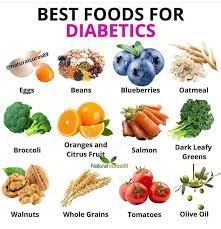Alright, folks, let’s talk about what’s on the no-go list for folks managing diabetes. You know, those foods that can send your blood sugar levels skyrocketing and leave you feeling less than stellar. Here’s what you might wanna steer clear of:
Sugary Drinks: Say bye-bye to soda, fruit juice, and sweetened tea. They’re loaded with sugar and can send your blood sugar levels on a rollercoaster ride.
Sweet Treats: Candy, cookies, cakes – you name it. These sugary delights might taste good, but they’re not doing your blood sugar any favors.
White Carbs: Think white bread, white rice, and pasta. They’re refined grains that can cause blood sugar spikes faster than you can say “carb overload.”
Fried Goodies: We’re talking about deep-fried delights like French fries and fried chicken. They’re full of unhealthy fats and can mess with your blood sugar control.
Processed Meats: Bacon, sausage, and deli meats are convenient, but they’re often loaded with sodium and unhealthy fats that can wreak havoc on your blood sugar.
Full-Fat Dairy: Whole milk, cheese, and cream might be tasty, but they’re also high in saturated fats, which aren’t great for blood sugar control.
Sweet Breakfast Cereals: Those colorful cereals you loved as a kid? Yeah, they’re packed with added sugars and refined grains that can send your blood sugar levels soaring.
Sugary Condiments: Ketchup, barbecue sauce, and sweet salad dressings might add flavor to your meals, but they also add unnecessary sugars.
Alcohol: While a drink now and then is okay, too much alcohol can mess with your blood sugar levels and lead to lows.
High-Carb Snacks: Chips, pretzels, and crackers might satisfy your cravings, but they’re also high in carbs and low in fiber, making them a no-go for blood sugar control.
Carbohydrates: The Energy Maestros
Understanding your carbohydrate intake is key in diabetes management. Carbs are the primary fuel source, yet managing their types and quantities is vital for maintaining blood glucose levels.
Instead, focus on a balanced diet rich in whole foods like fruits, veggies, lean proteins, and healthy fats. Keep an eye on your portion sizes and monitor your blood sugar levels to keep things in check. And don’t forget to work with your healthcare team to come up with a plan that works best for you.

Pros and Cons: Managing Foods and Drinks for Diabetes with Dietary Choices
Pros:
- Improved Blood Sugar Control: Choosing the right foods can significantly stabilize blood sugar levels.
- Reduced Risk of Complications: A balanced diet lowers the chances of diabetes-related complications like heart disease.
- Enhanced Overall Health: Nutrient-rich foods improve general health, not just diabetes management.
- Increased Energy Levels: Proper nutrition ensures steady energy throughout the day.
- Emotional Well-Being: A diet that supports diabetes management can also boost mood and mental health.
Cons:
- Dietary Restrictions: Managing diabetes may mean giving up or limiting certain favorite foods.
- Constant Monitoring: Requires regular monitoring of blood sugar levels to adjust dietary choices.
- Potential for Nutrient Deficiency: Restricting certain foods could lead to a lack of essential nutrients if not carefully balanced.
- Time and Effort: Preparing and planning diabetes-friendly meals can be time-consuming.
- Social and Dining Challenges: Navigating social gatherings and dining out can be difficult with dietary restrictions.
FAQs: Managing Foods and Drinks for Diabetes Through Diet
- What are the best foods to eat for managing diabetes?
- Foods rich in fiber, lean protein, healthy fats, and with a low to medium glycemic index, like non-starchy vegetables, whole grains, lean meats, and fruits, are ideal.
- Can I still enjoy sweets if I have diabetes?
- Yes, in moderation. Focus on portion control and opt for healthier alternatives with less added sugar.
- How do carbohydrates affect blood sugar levels?
- Carbohydrates break down into glucose, impacting blood sugar levels. Choosing complex carbs with fiber can help manage these levels better.
- Is it safe to drink alcohol if I have diabetes?
- Alcohol can affect blood sugar levels and interact with medications. If you choose to drink, do so in moderation and consult with your healthcare provider.
- Can a diabetic diet help with weight loss?
- A well-planned diabetic diet, focusing on portion control and nutrient-rich foods, can aid in weight loss and overall health improvement.
- Do I need to completely avoid sugar-sweetened beverages?
- It’s advisable to limit or avoid sugar-sweetened beverages, as they can cause spikes in blood sugar levels and provide empty calories.
- How can I make healthier food choices when dining out?
- Look for menu items that are grilled, baked, or steamed, ask for dressings or sauces on the side, and be mindful of portion sizes.
- Are “diabetic foods” a better choice?
- Not necessarily. Some “diabetic foods” can still affect blood sugar levels or contain artificial sweeteners. Always read labels and make informed choices.
- How does fiber affect diabetes?
- Fiber helps slow the absorption of sugar into the bloodstream, aiding in blood sugar control and providing a feeling of fullness.
- Can I eat fruit if I have diabetes?
- Yes, fruits are healthy and can be included in a diabetic diet. Opt for whole fruits and be mindful of portion sizes and the glycemic index.
Foods and Drinks for Diabetes Takeaway


